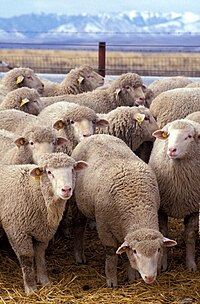
Insulating composites made from sulfur, canola oil, and wool.
Sign Up to like & getrecommendations! Published in 2021 at "ChemSusChem"
DOI: 10.1002/cssc.202100187
Abstract: An insulating composite was made from the sustainable building blocks wool, sulfur, and canola oil. In the first stage of the synthesis, inverse vulcanization was used to make a polysulfide polymer from the canola oil… read more here.
Keywords: canola oil; wool; polymer; sulfur canola ... See more keywords

Pulverization of fibrous mineral wool waste
Sign Up to like & getrecommendations! Published in 2018 at "Journal of Material Cycles and Waste Management"
DOI: 10.1007/s10163-017-0692-3
Abstract: The total annual volume of mineral wool waste in the 27 European Union countries is expected to increase to 2.5 million tons per year by 2020. Unfortunately, mineral wool wastes are often considered unrecyclable, because their… read more here.
Keywords: mineral wools; wool; pulverization fibrous; wool waste ... See more keywords

Factors affecting wool characteristics of sheep reared in Kashmir
Sign Up to like & getrecommendations! Published in 2020 at "Tropical Animal Health and Production"
DOI: 10.1007/s11250-020-02238-1
Abstract: This study was conducted on 82,908 records of purebred and upgraded Kashmir Merino sheep to evaluate the performance of breed over the years. The data pertaining to fiber diameter (FD), staple length (SL), clean wool… read more here.
Keywords: wool; characteristics sheep; factors affecting; kashmir ... See more keywords

A bio-antifelting agent based on waterborne polyurethane and keratin polypeptides extracted by protease from waste wool
Sign Up to like & getrecommendations! Published in 2017 at "Fibers and Polymers"
DOI: 10.1007/s12221-017-6723-9
Abstract: A bio-composite made from keratin polypeptides and waterborne polyurethane was firstly employed as a bioantifelting agent for wool fabric. The keratin polypeptides, extracted from the waste wool fibers with the protease Esperase8.0L, possessed 5271 weight-average… read more here.
Keywords: keratin polypeptides; waterborne polyurethane; wool; bio ... See more keywords

Dual-mode adsorption of cochineal natural dye on wool fibers: Kinetic, equilibrium, and thermodynamic studies
Sign Up to like & getrecommendations! Published in 2017 at "Fibers and Polymers"
DOI: 10.1007/s12221-017-6923-3
Abstract: The dual-mode adsorption model was used to investigate the adsorption behavior of cochineal natural dye on wool fibers. Kinetic, thermodynamic, and equilibrium characteristics were investigated in terms of the adsorption isotherm, affinity, enthalpy and entropy… read more here.
Keywords: dual mode; adsorption; dye wool; wool ... See more keywords

LED-UV grafting of vinylsulfone dyes onto photo-oxidized wool fabrics
Sign Up to like & getrecommendations! Published in 2017 at "Fibers and Polymers"
DOI: 10.1007/s12221-017-7287-4
Abstract: Photografting coloration of wool was carried out under UV-LED irradiation at room temperature using aqueous vinylsulfone dye solution containing vinylsulfonic acid as a comonomer. UV-LED irradiation of the 395 nm emission is more energy efficient,… read more here.
Keywords: wool; led grafting; grafting vinylsulfone; wool fabrics ... See more keywords

Surface Modification of Wool Fabric with POSS® Nanomaterial
Sign Up to like & getrecommendations! Published in 2018 at "Fibers and Polymers"
DOI: 10.1007/s12221-018-1169-2
Abstract: Wool fabrics, without any surface treatment, can undergo undesirable and irreversible structural changes of wool fiber during washing under heat and mechanical agitation, leading to high shrinkage of wool garments. The traditional method based on… read more here.
Keywords: wool; poss; treatment; surface ... See more keywords

Eco-friendly Grafting of Chitosan as a Biopolymer onto Wool Fabrics Using Horseradish Peroxidase
Sign Up to like & getrecommendations! Published in 2019 at "Fibers and Polymers"
DOI: 10.1007/s12221-019-8546-3
Abstract: Chitosan and enzymes have been extensively used in modification of wool, due to their non-toxic and eco-friendly characteristics, as well as to reduce pollution in textile production. In the present work, chitosan was grafted onto… read more here.
Keywords: wool; eco friendly; chitosan grafted; onto wool ... See more keywords

Novel One Step Printing and Functional Finishing of Wool Fabric Using Selenium Nanoparticles
Sign Up to like & getrecommendations! Published in 2020 at "Fibers and Polymers"
DOI: 10.1007/s12221-020-9461-3
Abstract: This study demonstrates the possibility of one step printing and multifunctional finishing of wool fabrics using synthesized selenium nanoparticles (Se-NPs) as stable functional colorant. Se-NPs formation was emphasized using visible changes, UV-visible absorption spectra, and… read more here.
Keywords: step printing; microscopy; wool; finishing wool ... See more keywords

The Influence of Moisture Content on Shrinkage of Wool Fabrics during Domestic Tumble Drying Process
Sign Up to like & getrecommendations! Published in 2021 at "Fibers and Polymers"
DOI: 10.1007/s12221-021-9207-x
Abstract: Shrinkage of wool fabrics caused during tumble drying is a serious defect. In the drying process, the felting shrinkage of wool fabrics was influenced by the moisture content and temperature of wool fabric as well… read more here.
Keywords: moisture; wool; shrinkage wool; wool fabric ... See more keywords

Assessment of Two Sheep Wool Residues from Textile Industry as Organic Fertilizer in Sunflower and Maize Cultivation
Sign Up to like & getrecommendations! Published in 2019 at "Journal of Soil Science and Plant Nutrition"
DOI: 10.1007/s42729-019-00079-y
Abstract: Sustainable agricultural practices that enhance soil fertility and increase its capacity for carbon sequestration are increasingly needed. This study evaluates two types of sheep wool residues (SWRs)—carbonized (black wool, BW) and non-carbonized (white wool, WW)… read more here.
Keywords: wool residues; soil; swrs; biomass ... See more keywords